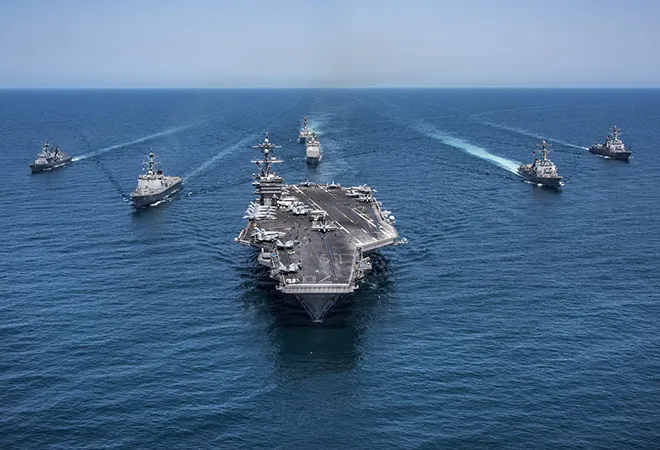
The United States has recently declassified one of its primary national security documents—the 2018 Indo-Pacific strategic framework, which was developed by the National Security Council through the course of 2017. In policy sectors, the document has received a mixed reception with it being seen as hackneyed to being perceived as reassuring and as a recognition of the work done by the Trump administration. The uncharacteristic early release of the document on 12 January 2021—within 2 years of its adoption in 2018 when it was set to be made public not before 2043—and in the final few days of the Trump administration point to the reinforcing of US position on China and the Indo-Pacific.
Continuity and change
In the US’ Indo-Pacific Strategy Report, which was released on 1 June 2019 at the Shangri-La Dialogue, the strategy put forward by the US was conceived more as a military one, where China was categorically termed as a “Revisionist Power” and where partnership with like-minded countries in the region was seen as “a force multiplier to achieve peace, deterrence and interoperable warfighting capability, employing deterrence through a Joint Force and the US combat credible forces along with its allies and partners to be forward deployed in the region to win any conflict from its onset.” This strategy had put the US in a leading role and reiterated Trump’s ‘America First’ policy stance. In the declassified document too, China’s growing assertiveness has been recognised, “prevent China’s industrial policies and unfair trading practices from distorting global markets and harming US competitiveness”, but still the wording has been less exacting and not as outright as in the other official documents released by the Trump administration. The focus has been put more on “working alongside and encouraging like-minded countries to play a greater role in addressing the challenges and in increasing burden-sharing. Sharing the benefits of US’ research and development with allies and like-minded partners to retain collective military edge.” Instead of just focussing on strengthening defence and military cooperation, this document puts forward other prospective areas of cooperation as well, like information operations, advanced technology research and infrastructure investment.
The declassified document shows that the US’ Indo-Pacific strategy has been in a big way influenced by its allies and partners in the region—India, Australia and Japan. Rory Medcalf of the National Security College at the Australian National University, rightly points out, “one of the strategy’s plainest successes was fulfilling the objective to create a quadrilateral security framework with India, Japan, Australia, and the United States as the principal hubs”.
The declassified document shows that the US’ Indo-Pacific strategy has been in a big way influenced by its allies and partners in the region—India, Australia and Japan.
India’s role
These recently declassified US documents on the Indo-Pacific recognise India as a capable and reliable partner to the geostrategic outlook of the US and ‘like-minded’ countries. In continuation of the steadily deepening ties between Washington and New Delhi since the Clinton, Bush, Obama and most recently, the Trump administrations, the document identifies India as a ‘preferred partner’ and a ‘net security provider’ in the region.
While defence and trade have formed the foundation of bilateral ties, New Delhi has over the course of the previous decade increasingly been counted on by Washington across diverse sectors of cooperation in South Asia and the broader Indo-Pacific ranging from connectivity to security spurred by shared geostrategic concerns. Naturally, this aspect is highlighted in the declassified documents, which underscore India’s role in multilateral efforts at containing the spread of Beijing’s overbearing influence across the length and breadth of the Indo-Pacific.
While defence and trade have formed the foundation of bilateral ties, New Delhi has over the course of the previous decade increasingly been counted on by Washington across diverse sectors of cooperation in South Asia and the broader Indo-Pacific ranging from connectivity to security spurred by shared geostrategic concerns
Additionally, the document also underscores India’s capability in terms of defending its northern borders from Chinese incursions and asserts that in South Asia, the country retains its role as the key preserver of security. This subsequently creates room for active economic, defense and diplomatic cooperation with its other allies and partners in the region. Emphasising and recognising New Delhi’s expanding role in its immediate neighbourhood also draws attention to the country’s enhanced position in regard to partnering with key US allies in the region—Japan and Australia. Alongside these already existing and expanding sectors of collaboration with India, the files also urge collaboration with India in cyber and space security and the augmentation of maritime domain awareness. With connectivity having been the highlight of intra-region cooperation over the past few years, the files also mention working with New Delhi and Tokyo to finance projects which would enhance regional connectivity and in turn strengthen the capacity of emerging countries like Sri Lanka, Maldives and Bangladesh.
The objective of deepening ties with India and also according it a more prominent position as a key regional player is primarily to counterbalance China. To cultivate the scope of India’s role, the document encourages military, intelligence and diplomatic support thereby complementing India’s compatibility with the vision of the US, Japan, and Australia for a Free and Open Indo-Pacific.
What lies ahead for the Biden Administration?
During his election campaign, and even after his victory, President elect Joe Biden had ignored using the term ‘Indo-Pacific’, had even a few times gone back to using the ‘Asia-Pacific’ terminology and had switched from ‘Free and Open Indo-Pacific’ to an undefined and unspecified “Secure and Prosperous Indo-Pacific”. The release of the classified document is especially pertinent in the wake of apprehensions regarding the possibility of a less hardline approach by the incoming Biden administration. In other words, it signals the continuity in policy that officials in the US wish to maintain across the political transfer of power. Additionally, the appointment of top American diplomat Kurt M Campbell as the ‘Indo-Pacific Coordinator’, just a day after the White House declassified the Trump administration’s Indo-Pacific’s strategy also aims at brushing away the reservations in the minds of the allies and partners of the US in the Indo-Pacific region about the hesitation as to whether a strong policy aimed at containing the rise of China will be pursued by the incoming Biden administration.
President-elect Biden has mainly been recruiting the members of the foreign policy team of the Obama administration. The appointment of Kurt Campbell as the ‘Indo-Pacific Coordinator’, who served as the assistant secretary of state for East Asian and Pacific Affairs under the Obama administration and had also played an instrumental role in crafting the ‘pivot to Asia’ policy, shows that ‘Asia’ will be an important focus area in his foreign policy calculus. Instead of using the former President Obama’s ‘Rebalance to Asia’ or ‘Asia Pivot’ policy, Trump had started using the term ‘Indo-Pacific’ which had been gaining traction for some time. But for Biden, it will be beneficial for Biden to keep on using the term Indo-Pacific, rather than reverting to ‘Asia-Pacific’ or ‘Asia Pivot’. The US’ championing the term Indo-Pacific had reinforced and encouraged countries like Japan, Australia, India, the ASEAN countries, even some European countries like France, Germany, and the UK to play a greater role in the Indo-Pacific and design their own policies and approaches.
Given that Biden plans to shift from Trump’s unilateral America First strategy and focus instead on “rebuilding our alliances”, it will be only logical for this administration to continue harping the Indo-Pacific terminology if the trust of its allies and partners in the region have to be kept intact. In this regard, the declassified document just released can be a good starting point for the Biden administration to build on his government’s Indo-Pacific strategy.
The views expressed above belong to the author(s). ORF research and analyses now available on Telegram! Click here to access our curated content — blogs, longforms and interviews.




 PREV
PREV



